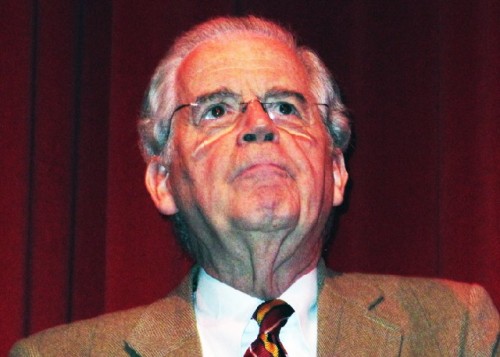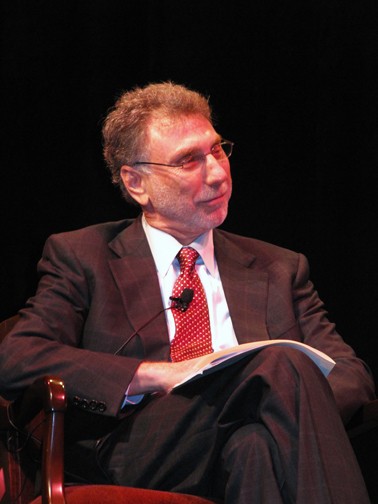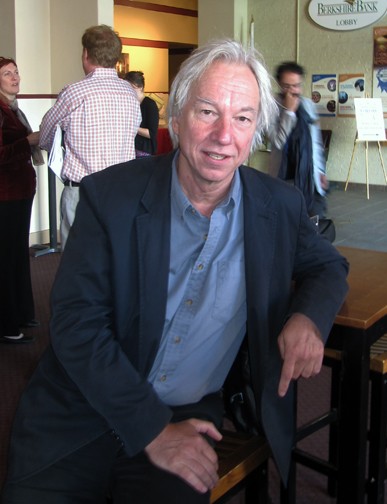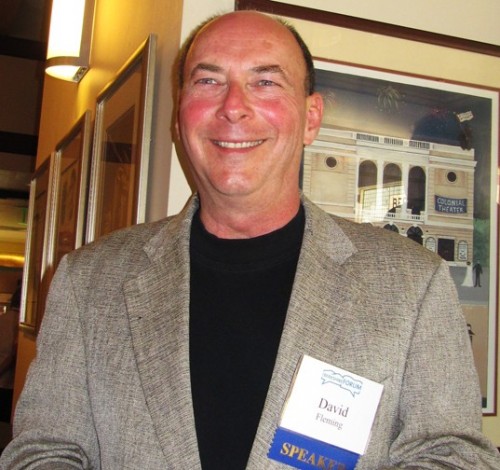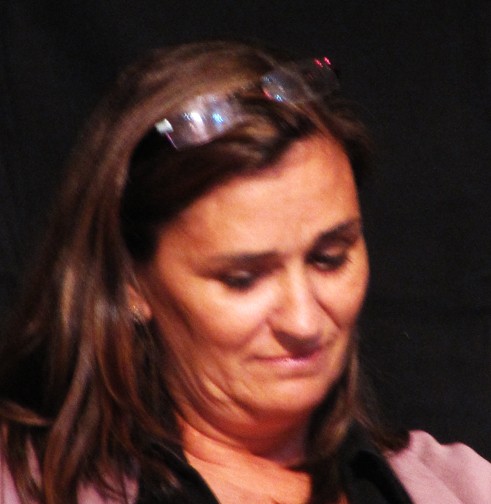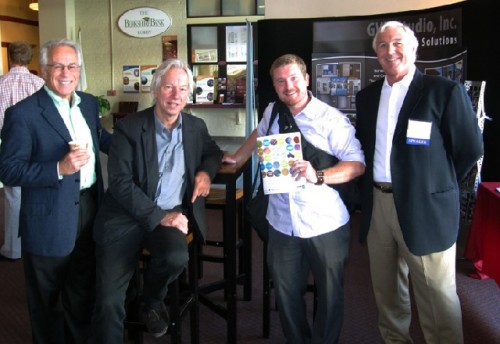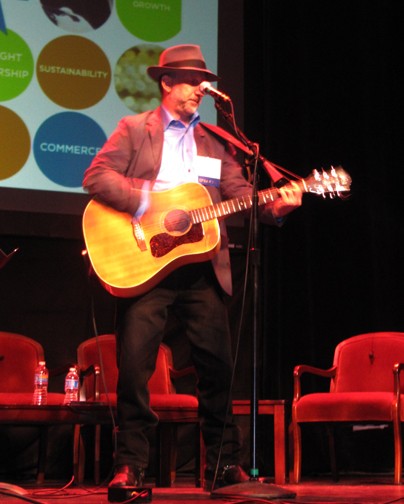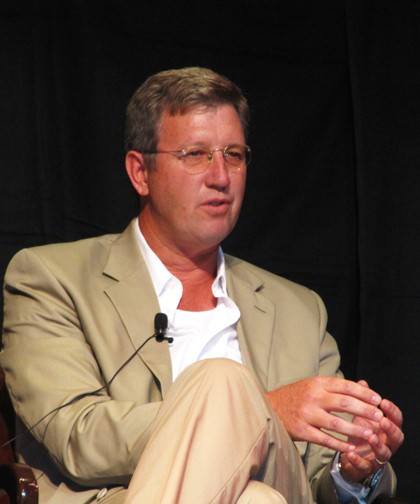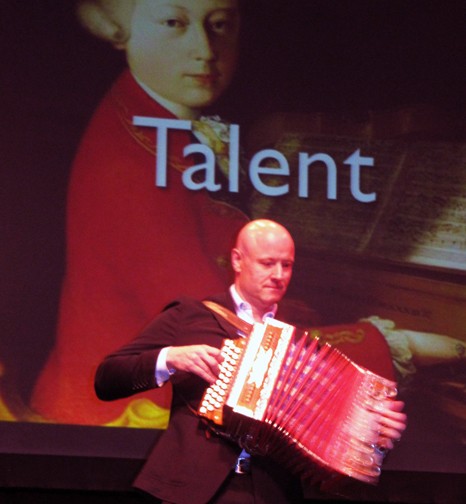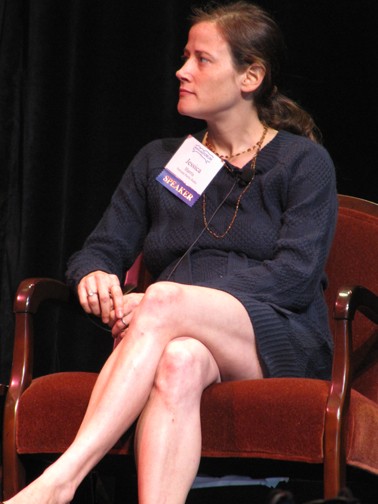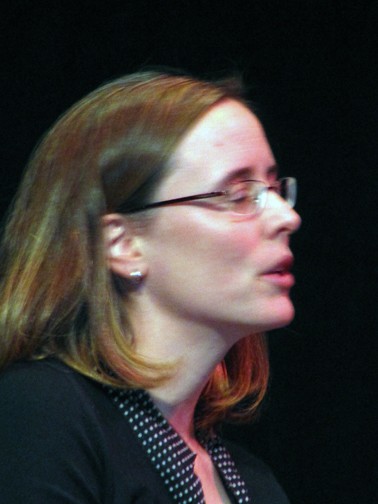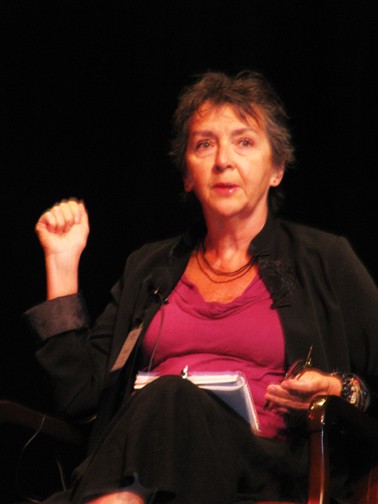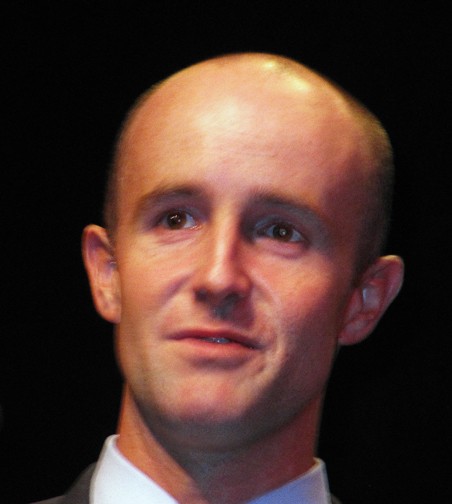Berkshire Forum 2010
Thinking Beyond Pride of Place
By: Charles Giuliano - Sep 17, 2010
The sparsely attended Berkshire Forum, September 14-16, at the Colonial Theatre, proved to be a high octane, insightful, and energizing event for the too few who participated and attended.
Despite the disappointing turnout, it was just $49 for three days packed with panels and distinguished speakers, the organizers Tina Chase and Mary Colling George, were sanguine on developing this as an annual event. With changes and adjustments that might not entail a return to the Colonial.
We spoke with Chase toward the end of the event on Thursday. With sponsorships she stated that the Forum was close to breaking even. That is most encouraging. She and her partner are experienced in creating similar events but this was their first in and about the Berkshires. Chase revealed that in the future they may organize more narrowly focused, one day events.
For this first gathering the overview was so broad that it created a staggering range of information to absorb. In some aspects it evoked the image of six blind men tasked to describe an elephant. That, of course, depended upon which part of the pachyderm you were holding on to.
Our primary motive for attending was the aspect of arts organizations and the creative economy. We were familiar with the players and issues. There was a steep and thought provoking learning curve through panels and speakers digging deeply into business and entrepreneurial issues, philanthropy, health care, education, technology and infrastructure, branding and marketing, quality of life and sustaining a healthy economy for the hospitality/ restaurant and retail community that extends beyond the intense summer season.
A prevailing impression was the ability of the organizers to recruit and assemble a remarkable range of individuals who are renowned for their expertise and creative brilliance. It was a very smart conference. As well as the opportunity to experience and hear the views of leaders in the business and philanthropy community that are normally off the radar screen.
By the nature of their business arts leaders are routinely accessible. They must have a strong presence and persona as a part of fund raising and marketing their product and programming. It was of course meaningful to experience them in a different context in dialogue with peers discussing common challenges. In a related article we will cover that in some depth.
It was most intriguing to hear from entrepreneurs who have settled in the region though inheritance of family owned businesses as well as the attraction of living in a rural setting with proximity to major centers in New York, Boston and Hartford. Business leaders who travel frequently commented on the ease of commuting in and out of the smaller and more convenient Albany International Airport. In that regard wish list items focused on better train connections with Pittsfield or creating a more direct access to the Mass Pike that does not snake through Lenox and Lee. Many of the panelists noted the two hour drive to New York or Boston which revealed them as mostly South County residents. There was discussion of the distances of connecting from one end of the Berkshires to another.
Much discussion from different panels and speakers touched on branding and defining the Berkshires. For me, in terms of Berkshire Fine Arts, the term implies a state of mind. It is Berkshires in the sense of the New Yorker which entails a global vision with urban sophistication. It combines the unique combination of a concentration of world class arts organizations, and a four seasons, rural setting. Of course, duly noted, one of those seasons is the notorious Mud months which are a nadir of bucolic bliss endured by locals and shunned by visitors. It is when restaurants and the hospitality industry wonder if they will survive to see another summer season. Which may or may not be all that great? This summer was better while last summer was a disaster.
There was debate about defining the geography of the Berkshires. Is there some leeching at the borders? Would one include Albany, Troy, Bennington, Springfield, Pioneer Valley, or Saratoga as an extension and adjunct to the Berkshires? Panelists from the business community were generally affirmative of those extensions. The director of the Bennington Museum, Stephen Perkins, for example, noted that his institution is just twenty minutes away from the Clark in Williamstown.
In terms of the geography, the crucial drive time in a rural region, there was discussion of the emergence of Pittsfield as the hub. Of course that was a given when it was the home of General Electric. It was the economic focus of the Berkshires. But when GE downscaled, and Sprague left North Adams, there was a generic deflation. Joe Thompson noted that when Tom Krens proposed Mass MoCA, 21 years ago, unemployment in North Adams was about 20%. The city was infamous for all the worst social statistics from education to teenage pregnancy and crime. That was also true for Pittsfield. Beth Pearson discussed trying to develop what was formerly a crack house in a terrible Pittsfield neighborhood as “Boston apartments.” Gradually through improving and flipping homes neighborhoods have been upgraded with the rise in property values.
Under the agenda of quality of life business leaders and entrepreneurs discussed the desirability of living in the Berkshires. There were concerns that the region will evolve along the line of the Hamptons. What about the summer traffic in Great Barrington? Or the congestions of getting in and out of Lenox during Tanglewood?
Seth Rogovoy, the editor of Berkshire Living, and a moderator, put a stop to that notion. “I grew up on Long Island” he assured us adding that he lives on the main street in Great Barrington. “In the summer it takes like five to ten minutes to drive through Great Barrington.” No way is that like the Hamptons. Also, for all of its resources, the Berkshires lack the beach that attracts that Hamptons life style.
There was some ambivalence between branding and marketing the Berkshires and a concern of being overrun by tourists and those upscale folks with summer homes in the Hamptons. How to find the right mix between supporting and sustaining the hospitality and cultural industry without spoiling the delicate balance that makes the Berkshires affordable and livable?
The business leaders and entrepreneurs commented that the development of advanced communications have allowed for operating outside of major metropolitan areas. Being within commuting range is vital. It is possible to be headquartered in the Berkshires, taking full advantage of the lifestyle, while operating nationally and globally. Several panelists spoke of weekly travel as a part of their business. This entailed manufacturing and clients in India and China.
That defines a different kind of business model. While blue collar labor is readily available there are problems recruiting executive talent, particularly power couples. They may relocate for one job offer which renders highly trained and specialized spouses unemployable. An example was given where an executive was hired. His wife is an expert in pharmaceuticals. Good luck on that.
Given the persistently high levels of unemployment the issues of education were discussed. When there were dominant, life long employers such as GE, Sprague, and paper mills, there was appropriate vocational training in the schools. Students learned trades. But just what are the skills to be taught in a nation that is moving away from manufacturing to larger investments in technology and intellectual property? The paradigm of the blue collar worker is in flux. The emerging industries of the Berkshires will require a far more diverse and skilled work force. Is there enough critical mass of skilled labor to make the region competitive with other sectors of the nation?
In general it is more expensive to live in the four seasons, north east. But executives and business leaders who have relocated from urban settings find their overall costs reduced by as much as a third. Which means that they maintain similar lifestyles on less compensation. There is the incentive of eliminating brutal commutes to the work place. Moving here may equate to at least a decade of longevity through stress reduction. Country folks just seem to last longer than city slickers.
Many of the moderators asked panelists for the equivalent of best and worst case scenarios. The sticking point appears to be infrastructure such as the cost of quickly and efficiently getting product to market. In this internet age the most glaring problem is on line access. This was addressed in the panel Broadband Expansion to Rural Communities: Growing Locally, Competing Globally. It was chaired by State Senator Benjamin Downing. He observed that of the 40 plus Massachusetts communities without high speed internet access the majority of those towns are in his district. The panelists included Judith Dumont, of the Massachusetts Broadband Institute, and Monica Webb of Wired West. With the development of fiber optics, and its ability for quick up and downloads of massive files, even DSL which is standard in much of the Berkshires is all but obsolete.
In order to compete the Berkshires must be on a level playing field with other business centers. The analogy was made to when the decision was made to bring electricity and telephone connections to the farms and rural areas of America. It was viewed as a national interest. The point was made that there must be similar efforts to get all of America on line. What is the best way to do that? To move forward we need to stay connected.
While there were remarkable high points over the three days there were also dead zones. It seemed that the events of the day were compressed with little opportunity for meeting and networking. When a session ended, for example, there were “arts and entertainment” intervals that bridged the time to the next session. This taste of culture was uneven and disruptive. It meant that speakers and the audience were pushed out or silenced. Mostly everyone dispersed after sessions. They might have lingered if there was consistent food and drink in the lobby. During lunch and dinner breaks, or the end of a day’s sessions, there was sporadic food or drink to induce one to linger.
Perhaps there might have been a morning coffee break, afternoon tea, and a cocktail hour after the Wednesday and Thursday sessions. There was a reception before the Tuesday evening lectures.
Some of the timing didn’t work well. A power point inspirational session with Kevin Sprague Creativity is a Muscle: Building a World Where Creativity Thrives was schedule to run from 8 to 8:20 AM. It actually started when it was supposed to end. That left the panel Cleantech: Building Sustainable Communities waiting in the wings. To keep on track that panel got squeezed despite lively questions. A better decision might have been to scrap Sprague’s late presentation and stay on schedule. The Cleantech session was one of the most informative of the Forum. That in turn tightened up Philanthropic Power; The Business of Giving. It was intriguing to meet and hear from individuals such as Jennifer Dowley who heads the $80 million Berkshire Taconic Community Foundation. The panel discussed the differences between foundations and angels.
Nancy Fitzpatrick, owner of the Red Lion Inn, described the strategies of her family run foundation as well as her individual giving. She was the only Berkshire resident on the board of the Boston Symphony Orchestra. Now Berkshire native Kim Taylor, the wife of James Taylor, is also a BSO board member. Fitzpatrick also sits on the Mass MoCA board.
Seth Rogovoy wears a lot of different hats. Literally. With humor he introduced his Dylan inspired interval as hovering between performance and comedy. There was another element as we quoted from his book while singing Dylan’s anthems. He stayed on stage to introduce inspirational, self help speaker, Carole Hyatt. After lunch he returned to chair the session on Finding the Where of Happiness: Realizing the American Dream in Rural America.
During questions for that panel Fitzpatrick raised the important question, central to the hospitality and cultural tourism industry, of creating a critical mass of programming and visitation beyond just July and August.
It is such a key issue that it was an oversight not to have a panel devoted to marketing/ tourism/ hospitality and shoulder seasons. It was a topic that kept popping up in a lot of discussions. But there never seemed to be quite the right fit to explore this crucial agenda in depth.
The general assumption is that after Labor Day we just roll up the streets. If you visit Tanglewood off season it is boarded up. That seems to be the image and analogy of the creative community. Surely the power and energy of Tanglewood drives the economic engine of the Berkshires. But just for two of twelve months.
It was significant that none of the four major theatre companies or Jacob’s Pillow were participants in any of the panels. The chair of Jacob’s Pillow’s board, Joan Hunter, was a last minute, unscheduled addition to the panel on philanthropy. Kate Maguire, the artistic director of Berkshire Theatre Festival introduced a highlight from the current production of Annie. But important arts leaders like Maguire were not a part of the discourse.
Kelley Vickery of the Berkshire International Film Festival was on a panel. But where were representatives of the Williamstown Film Festival, DownStreet, Images Cinema, North Adams Open Studios, Storefront Artists, Topia, Williams College, the Clark, MCLA, and others who sustain programming during the all important shoulder seasons and beyond?
It was often pointed out that there are some 1,100 non profit organizations in the Berkshires. With humor it was suggested “Please don’t form any more non profits. It is better to merge with and support the ones that exist.” There was discussion of the misleading notion of a non profit as not making any money and being dependent on grants and giving. That led to the term of achieving an “operational surplus” which means earning more than annual operating expenses.
We have also seen arts organizations like Shakespeare & Company and The Mount facing debt that threatens their survival. Both are making progress. But there are only so many resources to appeal to. The more visible donors are tapped out.
Joe Thompson describes a precarious moment in the history of Mass MoCA. Before leaving office Governor Michael Dukakis wrote the first check for some $600,000 toward the pledge of $35 million. He told Joe to spend it wisely as the next governor, Bill Weld, may not be so supportive. Shortly after taking office Weld sent Thompson an order to “cease and desist.” With a smile Thompson related that by then “We had spent the money.” When he met with the governor Thompson had a notebook with pledges of $1 million from some 650 individuals. Weld responded that this represented “a problem” as many of the signatures represented important constituents. The majority of the gifts, contingent on the state releasing promised funding, were in amounts of under $1,000.
By the end of the Thursday sessions, and another ten hour day, I was feeling exhausted. It was a struggle to stay focused on the dialogue. But the sessions ended with a remarkable conversation between Eugenie Sills of The Women’s Times and Martin Baron the editor of the Boston Globe. He spoke frankly of the challenges of print journalism. In the nine years of his watch the news room of the Globe has been reduced by some 36%. He described the commitment and expense of maintaining the quality of journalism. The former director of the Globe’s investigative Spotlight team is now a professor of investigative journalism at Northeastern University. The Globe partners with Northeastern as well as Boston University on projects. But all editing prior to publication is overseen by Globe staff.
Investigative reporting is vital but costly. Baron estimated that the Globe’s series on sexual abuse in the Catholic Church, which had global impact, cost about $1 million. It is the kind of expense that the regional Berkshire Eagle cannot afford. Given the pressures from on line reporting and cable news, the erosion of ad revenue, the quality of reporting has been negatively impacted. For those reporters who survive work loads and pressures have just escalated. With the breakup of print’s hegemony, and the growth of on line blogging, unfounded rumors quickly become “facts.” Like the misinformation that Obama is a Muslim with an Indonesian passport. I heard that “reported” by a caller to a TV news program just this morning. The Tea Party thrives in this climate of misinformation.
It was intriguing to hear Baron’s responses to developing the Globe’s website and the commonly held notion that information and intellectual property are free. He noted that the Wall Street Journal charges for its on line access. Baron stated that all major news organizations are exploring ways to charge for their websites. Of course that is a risky strategy as surfers seek out other sources for information.
Today, I am attempting to sort through all of the content of the past three days. To connect the dots of threads of insight and information. The immediate conclusion is that the Forum has greatly expanded the reach of the term Berkshires. It defines an epicenter from which emanate ever wider circles of thought and influence. No, the Berkshires are not the center of the universe. But pretty damned close. We aren’t The Hamptons or Silicon Valley. Well, not yet.


